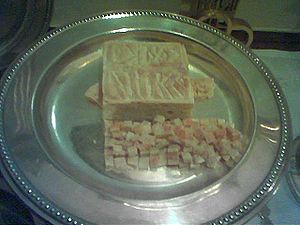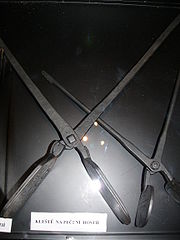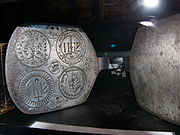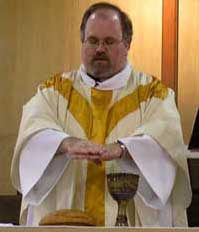
Sacramental bread
Encyclopedia
Sacramental bread, sometimes called the lamb, altar bread, host or simply Communion bread, is the bread which is used in the Christian ritual of the Eucharist
.

The Eastern Catholic and Eastern Orthodox
Church uses leavened bread for the Eucharist. Thus, the sacramental bread symbolizes the Resurrected Christ
. The sacramental bread, known as prosphorá
or a πρόσφορον (prósphoron, offering) may be made out of only four ingredients:
Sometimes holy water
will be either sprinkled into the dough or on the kneading trough at the beginning of the process.
The baking may only be performed by a believing Orthodox Christian in good standing — having preferably been recently to Confession
, and is accompanied by prayer and fasting. Before baking, each loaf is formed by placing two disks of dough, one on top of the other, and stamping it with a special liturgical seal. The prosphora should be fresh and not stale or moldy when presented at the altar
for use in the Divine Liturgy
. Often several prosphora will be baked and offered by the faithful, and the priest chooses the best one for the Lamb (Host) that will be consecrated. The remaining loaves are blessed and offered back to the congregation after the end of the Divine Liturgy
(Eucharist); this bread is called the Antidoron
(Greek
: αντίδωρον, antídōron), i.e. a "gift returned", or "in place of the Gifts".

 A host is a portion of bread used for Holy Communion in many Christian
A host is a portion of bread used for Holy Communion in many Christian
churches. In Western Christianity
the host is often a thin, round unleavened
wafer.

 The word "host" is derived from the Latin hostia, which means "sacrificial victim
The word "host" is derived from the Latin hostia, which means "sacrificial victim
". The term can be used to describe the bread both before and after consecration
, though it is more correct to use it after consecration - "altar bread" being preferred before consecration. Western theology teaches that at the Words of Institution
the bread is changed or altered (known as either transubstantiation
or transignification
according to tradition or denomination) into the Body of Christ
, while Eastern theology sees the epiclesis
as no less necessary.
Hosts are often made by nun
s as a means of supporting their religious communities. In the Latin Rite, unleavened bread
is used as in the Jewish Passover
or Feast of Unleavened Bread. The Byzantine Rite
Eastern Catholic Churches (like the Eastern Orthodox Church
) use leavened bread for Prosphora
(the Greek word for Eucharistic altar bread). The Armenian Catholic Church
(like the Armenian Apostolic Church
), the Syro-Malabar Church and the Maronite Church
have adopted the use of unleavened bread (see liturgical latinisation
). Some traditions proscribe the use of spiced, flavored or sweetened hosts, while others allow it. However, both Eastern and Western traditions insist that the bread must be made from wheat. The Code of Canon Law
, Canon 924 requires that the hosts be made from wheat flour only and recently made so that there is no danger of spoiling.
The General Instruction of the Roman Missal
§321 recommends that "the eucharistic bread ... be made in such a way that the priest at Mass with a congregation is able in practice to break it into parts for distribution to at least some of the faithful. ... The action of the fraction
or breaking of bread, which gave its name to the Eucharist
in apostolic times, will bring out more clearly the force and importance of the sign of unity of all in the one bread, and of the sign of charity by the fact that the one bread is distributed among the brothers and sisters."
 In the varying Protestant denominations, there is a wide variety of practices concerning the sacramental bread used. Some, such as the Christian Congregation
In the varying Protestant denominations, there is a wide variety of practices concerning the sacramental bread used. Some, such as the Christian Congregation
use leavened loaves of bread, others, such as Lutheran
s, continue to use unleavened wafers like the Roman Catholics, and some use matzo
. Even among those who use the unleavened wafers, there is a great deal of variation: some are square or triangular rather than round, and may even be made out of whole wheat flour
.
27:2) Different congregations may use either commercial bread or homemade bread prepared by members of the congregation. It is permissible to substitute rice cakes or other gluten-free breads for members who suffer from food allergies. The bread is broken into fragments just prior to being blessed by the officiating priest.
Eucharist
The Eucharist , also called Holy Communion, the Sacrament of the Altar, the Blessed Sacrament, the Lord's Supper, and other names, is a Christian sacrament or ordinance...
.
Eastern Catholic and Orthodox

The Eastern Catholic and Eastern Orthodox
Eastern Orthodox Church
The Orthodox Church, officially called the Orthodox Catholic Church and commonly referred to as the Eastern Orthodox Church, is the second largest Christian denomination in the world, with an estimated 300 million adherents mainly in the countries of Belarus, Bulgaria, Cyprus, Georgia, Greece,...
Church uses leavened bread for the Eucharist. Thus, the sacramental bread symbolizes the Resurrected Christ
Resurrection of Jesus
The Christian belief in the resurrection of Jesus states that Jesus returned to bodily life on the third day following his death by crucifixion. It is a key element of Christian faith and theology and part of the Nicene Creed: "On the third day he rose again in fulfillment of the Scriptures"...
. The sacramental bread, known as prosphorá
Prosphora
A prosphoron is a small loaf of leavened bread used in Orthodox Christian and Greek Catholic liturgies. The plural form is prosphora...
or a πρόσφορον (prósphoron, offering) may be made out of only four ingredients:
- fine (white) wheat flourWheat flourWheat flour is a powder made from the grinding of wheat used for human consumption. More wheat flour is produced than any other flour. Wheat varieties are called "clean," "white," or "brown" if they have high gluten content, and they are called "soft" or "weak" flour if gluten content is low...
- pure water
- yeast
- salt
Sometimes holy water
Holy water
Holy water is water that, in Catholicism, Anglicanism, Eastern Orthodoxy, Lutheranism, Oriental Orthodoxy, and some other churches, has been sanctified by a priest for the purpose of baptism, the blessing of persons, places, and objects; or as a means of repelling evil.The use for baptism and...
will be either sprinkled into the dough or on the kneading trough at the beginning of the process.
The baking may only be performed by a believing Orthodox Christian in good standing — having preferably been recently to Confession
Confession
This article is for the religious practice of confessing one's sins.Confession is the acknowledgment of sin or wrongs...
, and is accompanied by prayer and fasting. Before baking, each loaf is formed by placing two disks of dough, one on top of the other, and stamping it with a special liturgical seal. The prosphora should be fresh and not stale or moldy when presented at the altar
Altar
An altar is any structure upon which offerings such as sacrifices are made for religious purposes. Altars are usually found at shrines, and they can be located in temples, churches and other places of worship...
for use in the Divine Liturgy
Divine Liturgy
Divine Liturgy is the common term for the Eucharistic service of the Byzantine tradition of Christian liturgy. As such, it is used in the Eastern Orthodox and Eastern Catholic Churches. Armenian Christians, both of the Armenian Apostolic Church and of the Armenian Catholic Church, use the same term...
. Often several prosphora will be baked and offered by the faithful, and the priest chooses the best one for the Lamb (Host) that will be consecrated. The remaining loaves are blessed and offered back to the congregation after the end of the Divine Liturgy
Divine Liturgy
Divine Liturgy is the common term for the Eucharistic service of the Byzantine tradition of Christian liturgy. As such, it is used in the Eastern Orthodox and Eastern Catholic Churches. Armenian Christians, both of the Armenian Apostolic Church and of the Armenian Catholic Church, use the same term...
(Eucharist); this bread is called the Antidoron
Antidoron
The Antidoron is ordinary leavened bread which is blessed but not consecrated and distributed in Eastern Orthodox Churches and less often in Eastern Catholic Churches that use the Byzantine Rite...
(Greek
Greek language
Greek is an independent branch of the Indo-European family of languages. Native to the southern Balkans, it has the longest documented history of any Indo-European language, spanning 34 centuries of written records. Its writing system has been the Greek alphabet for the majority of its history;...
: αντίδωρον, antídōron), i.e. a "gift returned", or "in place of the Gifts".
Catholic Church


Christian
A Christian is a person who adheres to Christianity, an Abrahamic, monotheistic religion based on the life and teachings of Jesus of Nazareth as recorded in the Canonical gospels and the letters of the New Testament...
churches. In Western Christianity
Western Christianity
Western Christianity is a term used to include the Latin Rite of the Catholic Church and groups historically derivative thereof, including the churches of the Anglican and Protestant traditions, which share common attributes that can be traced back to their medieval heritage...
the host is often a thin, round unleavened
Azymes
Azymes is an archaic English word for the Jewish matzah, derived from the Greek word "ἄζυμος" for unfermented bread in Biblical times; the more accepted term in modern English is simply unleavened bread or matzah, but cognates of the Greek term are still used in many Romance languages Azymes is an...
wafer.


Sacrifice
Sacrifice is the offering of food, objects or the lives of animals or people to God or the gods as an act of propitiation or worship.While sacrifice often implies ritual killing, the term offering can be used for bloodless sacrifices of cereal food or artifacts...
". The term can be used to describe the bread both before and after consecration
Consecration
Consecration is the solemn dedication to a special purpose or service, usually religious. The word "consecration" literally means "to associate with the sacred". Persons, places, or things can be consecrated, and the term is used in various ways by different groups...
, though it is more correct to use it after consecration - "altar bread" being preferred before consecration. Western theology teaches that at the Words of Institution
Words of Institution
The Words of Institution are words echoing those of Jesus himself at his Last Supper that, when consecrating bread and wine, Christian Eucharistic liturgies include in a narrative of that event...
the bread is changed or altered (known as either transubstantiation
Transubstantiation
In Roman Catholic theology, transubstantiation means the change, in the Eucharist, of the substance of wheat bread and grape wine into the substance of the Body and Blood, respectively, of Jesus, while all that is accessible to the senses remains as before.The Eastern Orthodox...
or transignification
Transignification
Transignification is an idea originating from the attempts of modernist Roman Catholic theologians, especially Edward Schillebeeckx, to better understand the mystery of the Real Presence of Christ at Mass in light of a new philosophy of the nature of reality that is more in line with contemporary...
according to tradition or denomination) into the Body of Christ
Body of Christ
In Christian theology, the term Body of Christ has two separate connotations: it may refer to Jesus's statement about the Eucharist at the Last Supper that "This is my body" in , or the explicit usage of the term by the Apostle Paul in to refer to the Christian Church.Although in general usage the...
, while Eastern theology sees the epiclesis
Epiclesis
The epiclesis is that part of the Anaphora by which the priest invokes the Holy Spirit upon the Eucharistic bread and wine in some Christian churches.In most Eastern Christian traditions, the Epiclesis comes after the Anamnesis The epiclesis (also spelled epiklesis; from "invocation" or...
as no less necessary.
Hosts are often made by nun
Nun
A nun is a woman who has taken vows committing her to live a spiritual life. She may be an ascetic who voluntarily chooses to leave mainstream society and live her life in prayer and contemplation in a monastery or convent...
s as a means of supporting their religious communities. In the Latin Rite, unleavened bread
Unleavened Bread
Unleavened Bread is a 1900 novel by American writer Robert Grant....
is used as in the Jewish Passover
Passover
Passover is a Jewish holiday and festival. It commemorates the story of the Exodus, in which the ancient Israelites were freed from slavery in Egypt...
or Feast of Unleavened Bread. The Byzantine Rite
Byzantine Rite
The Byzantine Rite, sometimes called the Rite of Constantinople or Constantinopolitan Rite is the liturgical rite used currently by all the Eastern Orthodox Churches, by the Greek Catholic Churches , and by the Protestant Ukrainian Lutheran Church...
Eastern Catholic Churches (like the Eastern Orthodox Church
Eastern Orthodox Church
The Orthodox Church, officially called the Orthodox Catholic Church and commonly referred to as the Eastern Orthodox Church, is the second largest Christian denomination in the world, with an estimated 300 million adherents mainly in the countries of Belarus, Bulgaria, Cyprus, Georgia, Greece,...
) use leavened bread for Prosphora
Prosphora
A prosphoron is a small loaf of leavened bread used in Orthodox Christian and Greek Catholic liturgies. The plural form is prosphora...
(the Greek word for Eucharistic altar bread). The Armenian Catholic Church
Armenian Catholic Church
|- |The Armenian Catholic Church is an Eastern Catholic Church sui juris in union with the other Eastern Rite, Oriental Rite and Latin Rite Catholics who accept the Bishop of Rome as spiritual leader of the Church. It is regulated by Eastern canon law...
(like the Armenian Apostolic Church
Armenian Apostolic Church
The Armenian Apostolic Church is the world's oldest National Church, is part of Oriental Orthodoxy, and is one of the most ancient Christian communities. Armenia was the first country to adopt Christianity as its official religion in 301 AD, in establishing this church...
), the Syro-Malabar Church and the Maronite Church
Maronite Church
The Syriac Maronite Church of Antioch is an Eastern Catholic Church in full communion with the Holy See of Rome . It traces its heritage back to the community founded by Maron, a 4th-century Syriac monk venerated as a saint. The first Maronite Patriarch, John Maron, was elected in the late 7th...
have adopted the use of unleavened bread (see liturgical latinisation
Liturgical Latinisation
Liturgical Latinisation, also known as Latinisation, is the process by which liturgical and other aspects of the Churches of Eastern Christianity were altered to resemble more closely the practices of the Latin Rite of the Catholic Church...
). Some traditions proscribe the use of spiced, flavored or sweetened hosts, while others allow it. However, both Eastern and Western traditions insist that the bread must be made from wheat. The Code of Canon Law
Canon law (Catholic Church)
The canon law of the Catholic Church, is a fully developed legal system, with all the necessary elements: courts, lawyers, judges, a fully articulated legal code and principles of legal interpretation. It lacks the necessary binding force present in most modern day legal systems. The academic...
, Canon 924 requires that the hosts be made from wheat flour only and recently made so that there is no danger of spoiling.
The General Instruction of the Roman Missal
General Instruction of the Roman Missal
The General Instruction of the Roman Missal —in the Latin original, Institutio Generalis Missalis Romani —is the detailed document governing the celebration of Mass of the ordinary form of the Roman Rite of the Catholic Church since 1969...
§321 recommends that "the eucharistic bread ... be made in such a way that the priest at Mass with a congregation is able in practice to break it into parts for distribution to at least some of the faithful. ... The action of the fraction
Fraction (religion)
The Fraction is the ceremonial act of breaking the consecrated bread during the Eucharistic rite in some Christian denominations.-Roman Catholic:In the Roman Rite of the Catholic Church, it is accompanied by the singing or recitation of the Agnus Dei....
or breaking of bread, which gave its name to the Eucharist
Eucharist
The Eucharist , also called Holy Communion, the Sacrament of the Altar, the Blessed Sacrament, the Lord's Supper, and other names, is a Christian sacrament or ordinance...
in apostolic times, will bring out more clearly the force and importance of the sign of unity of all in the one bread, and of the sign of charity by the fact that the one bread is distributed among the brothers and sisters."
Protestant

Christian Congregation of Brazil
The Christian Congregation in Brazil is an evangelical denomination founded in that country by the Italian-American missionary Luigi Francescon .-History:...
use leavened loaves of bread, others, such as Lutheran
Lutheranism
Lutheranism is a major branch of Western Christianity that identifies with the theology of Martin Luther, a German reformer. Luther's efforts to reform the theology and practice of the church launched the Protestant Reformation...
s, continue to use unleavened wafers like the Roman Catholics, and some use matzo
Matzo
Matzo or matzah is an unleavened bread traditionally eaten by Jews during the week-long Passover holiday, when eating chametz—bread and other food which is made with leavened grain—is forbidden according to Jewish law. Currently, the most ubiquitous type of Matzo is the traditional Ashkenazic...
. Even among those who use the unleavened wafers, there is a great deal of variation: some are square or triangular rather than round, and may even be made out of whole wheat flour
Whole wheat flour
Whole wheat flour is a powdery substance derived by grinding or mashing the wheat's whole grain. It is used in baking but typically added to other "white" flours to provide nutrients , texture, and body to the finished product....
.
Latter-day Saint
The Church of Jesus Christ of Latter-day Saints (Mormons) has no strict rules on the type of bread used for sacramental purposes. Latter-day Saint scriptures state: "For, behold, I say unto you, that it mattereth not what ye shall eat or what ye shall drink when ye partake of the sacrament, if it so be that ye do it with an eye single to my glory — remembering unto the Father my body which was laid down for you, and my blood which was shed for the remission of your sins." (Doctrine and CovenantsDoctrine and Covenants
The Doctrine and Covenants is a part of the open scriptural canon of several denominations of the Latter Day Saint movement...
27:2) Different congregations may use either commercial bread or homemade bread prepared by members of the congregation. It is permissible to substitute rice cakes or other gluten-free breads for members who suffer from food allergies. The bread is broken into fragments just prior to being blessed by the officiating priest.
See also
- Body of ChristBody of ChristIn Christian theology, the term Body of Christ has two separate connotations: it may refer to Jesus's statement about the Eucharist at the Last Supper that "This is my body" in , or the explicit usage of the term by the Apostle Paul in to refer to the Christian Church.Although in general usage the...
- Sacramental wineSacramental wineSacramental wine, Communion wine or altar wine is wine obtained from grapes and intended for use in celebration of the Eucharist...
- ProsphoraProsphoraA prosphoron is a small loaf of leavened bread used in Orthodox Christian and Greek Catholic liturgies. The plural form is prosphora...
- Host DesecrationHost desecrationHost desecration is a form of sacrilege in Christianity involving the mistreatment or malicious use of a consecrated host— the sacred bread used in the Eucharistic service or Mass...
- Opłatek
- 1825 Anti-Sacrilege Law (France)
- Liturgical latinisationLiturgical LatinisationLiturgical Latinisation, also known as Latinisation, is the process by which liturgical and other aspects of the Churches of Eastern Christianity were altered to resemble more closely the practices of the Latin Rite of the Catholic Church...
- Lamb (Liturgy)
- ShowbreadShowbreadShowbread , in the King James Version: shewbread, in a biblical or Jewish context, refers to the cakes or loaves of bread which were always present on a specially dedicated table, in the Temple in Jerusalem as an offering to God...
(Judaism)

